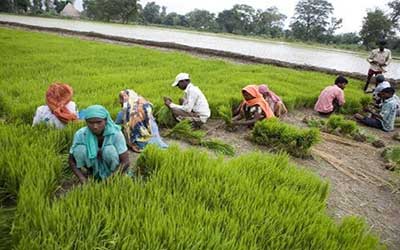Date: 20/05/2023
Relevance: GS-3: Food processing and related industries in India- scope
Key Phrases: National Council of Applied Economic Research, Rice-Wheat Cropping System, Technoparks and Research-Linked Incentives, Technology Development Board, Academic-Industry Collaboration.
Context:
- The recently released (National Council of Applied Economic Research)NCAER White Paper on ‘Making India a Global Power House in the Farm Machinery Industry’ reveals there is a mismatch between what the organised Indian industrial sector is producing and what the small and marginal Indian farmers want at an affordable price.
About the National Council of Applied Economic Research:
- The National Council of Applied Economic Research (NCAER) is an independent, non-profit research institution based in India.
- It was established in 1956 and is one of the country's premier economic think tanks.
- NCAER conducts policy-oriented research and analysis in various areas of applied economics and social development.
- The primary objective of NCAER is to promote high-quality research that informs policy formulation and decision-making at the national and regional levels.
Challenges Associated with the Mismatch:
- Affordability:
- Small and marginal farmers have limited financial resources, making it difficult for them to afford the machinery produced by the organized industrial sector.
- The high cost of farm machinery acts as a barrier to their adoption.
- Applicability:
- The farm machinery produced by the organized industrial sector often caters to large-scale farming practices and may not align with the needs and scale of small and marginal farmers.
- There is a lack of suitable machinery that suits their specific requirements.
- Limited R&D in Non-Tractors Farm Machinery (NTFM) Sector:
- The non-tractors farm machinery (NTFM) sector suffers from inadequate research and development efforts.
- This hampers the production of machinery that addresses the specific needs of small and marginal farmers.
- Lack of Customization:
- The existing farm machinery may not be suitable for the diverse agro-economic zones and cropping patterns in India.
- Small and marginal farmers require region- and crop-specific machinery that can enhance their productivity and efficiency.
- Medium-to-large firms, which account for a small proportion of the industry, are the main contributors to R&D.
- The private sector has seen increased participation in R&D, but agricultural engineering patents remain relatively low.
- Focus on Rice-Wheat Cropping System:
- Existing R&D programs in India primarily serve the rice-wheat cropping system, limiting agricultural diversification.
- Equipment for hill agriculture and horticulture mechanization is scarce, impeding innovation in areas such as irrigation, plant growth, and post-harvesting.
- Limited Academic-Industry Collaboration:
- Academic-industry collaboration is lacking in the farm machinery sector.
- The transfer of new designs and technology from research institutes to manufacturers/fabricators is inefficient.
- Initiatives like the Technology Development Board (TDB) under the Department of Science and Technology (DST) have had limited impact.

Do You Know?
-
About 75% of women workers in India are employed in the country’s agrarian sector (PLFS 2020-21).
Addressing the Mismatch:
- Promoting Research and Development:
- Increased investment in research and development in the NTFM sector is crucial.
- It should focus on developing cost-effective machinery specifically designed for small and marginal farmers.
- Collaborations between research institutes, agricultural universities, and industry can facilitate innovative solutions.
- Encouraging Public-Private Partnerships:
- Partnerships between the organized industrial sector and small-scale manufacturers, village craftsmen, and local entrepreneurs can lead to the production of affordable and locally relevant farm machinery.
- This collaboration can bring together the expertise of both sectors and address the demands of small and marginal farmers.
- Strengthening Academic-Industry Collaboration:
- Establishing strong links between research institutes, academic institutions, and industry can promote the transfer of technology and expertise.
- Technology Transfer Offices can facilitate this collaboration, allowing research findings to be effectively utilized by manufacturers and fabricators.
- Developing Region- and Crop-Specific Machinery:
- Emphasis should be placed on developing machinery that is suitable for different agro-economic zones, diverse crops, and varied topographies.
- This will require conducting research and understanding the specific needs of small and marginal farmers in different regions.
- Enhancing Access and Affordability:
- Government initiatives can be implemented to make farm machinery more accessible and affordable for small and marginal farmers.
- This can include subsidies, financial assistance, and cooperative models that enable collective ownership and shared utilization of machinery.
- Technoparks and Research-Linked Incentives: Establish technoparks where institutions, private firms, and faculty can collaborate on research projects.
- Legislation to Support Patent Ownership and Commercialization: Introduce a law similar to the Bayh-Dole Act to enable universities, non-profit research institutions, and small businesses to own, patent, and commercialize inventions resulting from government-funded research.
- Allow industries to utilize public academic lab facilities for a nominal fee.
- Encourage co-funding of R&D projects by universities and private partners.
- Implement the Start-up India scheme at ICAR institutes and establish incubation cells to foster entrepreneurship.
- Introduce research-linked incentives to promote innovation in light farm machinery and precision farming.
- Open and strengthen district-level patent offices and state agricultural university patent offices to cater to local communities.
- Foster corporate partnerships, similar to Maruti Suzuki Innovation in the auto sector.
Conclusion:
- A robust research and development ecosystem, coupled with strategic policy measures, will help bridge the gap between industrial production and farmer requirements, driving agricultural growth and productivity in the country.
Source: The Hindu BL
Mains Question:
Q. Discuss the mismatch between the organized Indian industrial sector and the demands of small and marginal farmers in the context of farm machinery. What are the challenges associated with this mismatch, and how can it be addressed?







